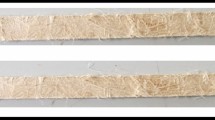Abstract
Ceramic matrix composites (CMCs) are potential thermo-structural materials for use in space applications. Fiber/matrix (F/M) interface plays a key role in determining the mechanical properties of CMCs. Present study focuses on the optimization of F/M volume ratio and the influence of Pyrocarbon (PyC) interphase coating on the mechanical properties of CMCs derived from precursor route. CMCs are fabricated using phenol formaldehyde (PF) resin and boron modified PF (BPF) resin as precursor slurries, 2D carbon fabric (Toray, T300 3K, 8H, satin weave) as reinforcement and PyC as interphase. The deposition of PyC interphase was done by chemical vapor infiltration on the carbon fabric followed by densification of the matrix using reaction bonded silicon carbide method. In CMCs prepared from PF resin, without interphase the flexural strength improves from 25 ± 3.9 MPa (fiber content-40) to 63 ± 9.9 MPa (fiber content-60) on increasing the fiber vol%. In the second part of the investigation, the effect of PyC interphase was studied using CMCs prepared from BPF resin with fiber volume ratio of 60 %. The CMCs with PyC interphase shows an improvement in flexural strength (102 ± 11.5 MPa) compared to that of CMCs prepared without interphase (38 ± 4.4 MPa). The fractography of CMCs with and without interphase was closely evaluated under a scanning electron microscope. CMCs without interphase show no fiber pull-out, indicating the strong fiber-matrix bonding. While CMCs with interphase show fiber pull-out phenomenon and hence fails in a ductile manner.







Similar content being viewed by others
References
K. Appiah, Z. Wang, W. Lackey, Characterization of interfaces in C fiber-reinforced laminated C/SiC matrix composites. Carbon 38, 831–838 (2000)
S. Schmidt, S. Beyer, H. Knabe, H. Immich, R. Meistring, A. Gessler, Advanced ceramic matrix composite materials for current and future propulsion technology applications. Acta Astronaut. 55, 409–420 (2004)
X. Cao, X. Yin, X. Fan, K. Zhao, H. Luo, L. Cheng, L. Zhang, High-temperature flexural properties of SiBC modified C/SiC composites. Ceram. Int. 40, 6185–6190 (2014)
Z. Wang, S. Dong, Y. Ding, X. Zhang, H. Zhou, J. Yang, B. Lu, Mechanical properties and microstructures of Cf/SiC–ZrC composites using T700SC carbon fibers as reinforcements. Ceram. Int. 37, 695–700 (2011)
R.R. Naslain, The design of the fibre-matrix interfacial zone in ceramic matrix composites. Compos. A Appl. Sci. Manuf. 29, 1145–1155 (1998)
K. Faber, Ceramic composite interfaces: properties and design. Annu. Rev. Mater. Sci. 27, 499–524 (1997)
R. Naslain, Design, preparation and properties of non-oxide CMCs for application in engines and nuclear reactors: an overview. Compos. Sci. Technol. 64, 155–170 (2004)
R. Naslain, J. Lamon, R. Pailler, X. Bourrat, A. Guette, F. Langlais, Micro/minicomposites: a useful approach to the design and development of non-oxide CMCs. Compos. A Appl. Sci. Manuf. 30, 537–547 (1999)
S. Bertrand, C. Droillard, R. Pailler, X. Bourrat, R. Naslain, TEM structure of (PyC/SiC) n multilayered interphases in SiC/SiC composites. J. Eur. Ceram. Soc. 20, 1–13 (2000)
X. Cao, X. Yin, X. Fan, L. Cheng, L. Zhang, Effect of PyC interphase thickness on mechanical behaviors of SiBC matrix modified C/SiC composites fabricated by reactive melt infiltration. Carbon 77, 886–895 (2014)
F. Lamouroux, G. Camus, Oxidation effects on the mechanical properties of 2D woven C/SiC composites. J. Eur. Ceram. Soc. 14, 177–188 (1994)
H. Yu, X. Zhou, W. Zhang, H. Peng, C. Zhang, Z. Huang, Mechanical properties of 3D KD-I SiCf/SiC composites with engineered fibre–matrix interfaces. Compos. Sci. Technol. 71, 699–704 (2011)
F.H. Zeng, X. Xiong, G.D. Li, B.Y. Huang, L. Jian, Microstructure and mechanical properties of 3D fine-woven punctured C/C composites with P y C/SiC/TaC interphases. Trans. Nonferr. Met. Soc. China 19, 1428–1435 (2009)
W. Zhang, L. Cheng, Y. Liu, L. Zhang, W. Yang, S. Zhou, Fracture behaviors and mechanism of 2D C/SiC-BC x composite under tensile load. Mater. Sci. Eng., A 530, 297–303 (2011)
T. Ganesh Babu, R. Devasia, Boron modified phenol formaldehyde resin based self-healing matrix for Cf/SiBOC composites. Adv. Appl. Ceram. (submitted)
A. Zmihorska-Gotfryd, Phenol-formaldehyde resols modified by boric acid. Polimery 5, 386–388 (2006)
J. Magnant, L. Maillé, R. Pailler, J.-C. Ichard, A. Guette, F. Rebillat, E. Philippe, Carbon fiber/reaction-bonded carbide matrix for composite materials—manufacture and characterization. J. Eur. Ceram. Soc. 32, 4497–4505 (2012)
F.D. Snell, C.L. Hilton, Encyclopedia of industrial chemical analysis, vol. 1, general techniques A–E, ed. by F.D. Snell, C.L. Hilton. Interscience Publishers, a div. of Wiley, J. Pharm. Sci., 55, 993–994 (1966)
C. Tong, L. Cheng, X. Yin, L. Zhang, Y. Xu, Oxidation behavior of 2D C/SiC composite modified by SiB4 particles in inter-bundle pores. Compos. Sci. Technol. 68, 602–607 (2008)
Acknowledgments
The authors thank the authorities of VSSC for granting permission to publish this work. One of the authors (Ganesh Babu T) is thankful to Indian Space Research Organization (ISRO) for the research fellowship. Help received from the members of the Analytical and Spectroscopy Division (ASD) for the thermal, chemical and spectral analyses is gratefully acknowledged.
Author information
Authors and Affiliations
Corresponding author
Rights and permissions
About this article
Cite this article
Ganesh Babu, T., Devasia, R. Boron Modified Phenol Formaldehyde Derived Cf/SiBOC Composites with Improved Mechanical Strength for High Temperature Applications. J Inorg Organomet Polym 26, 764–772 (2016). https://doi.org/10.1007/s10904-016-0366-y
Received:
Accepted:
Published:
Issue Date:
DOI: https://doi.org/10.1007/s10904-016-0366-y




